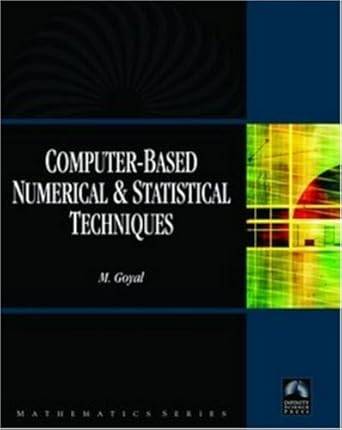Computer Based Numerical and Statistical Techniques
is a comprehensive guide crafted to meet the needs of students, professionals, and researchers working in the fields of computational mathematics, statistics, and data analysis. This meticulously designed resource provides a perfect blend of theoretical concepts and their practical applications, enabling readers to tackle real-world problems effectively.
With the growing relevance of numerical methods and statistical analysis in disciplines like engineering, computer science, economics, and the sciences, this book serves as an essential tool for mastering these techniques.
At its core, “Computer-Based Numerical and Statistical Techniques” emphasizes a computer-oriented approach, ensuring that readers not only grasp the mathematical foundations but also learn how to implement these concepts using computational tools. From solving complex equations using numerical methods to analyzing datasets with statistical techniques,
the book offers a well-rounded perspective that bridges the gap between theoretical knowledge and its practical execution. It introduces readers to a range of numerical methods such as interpolation, numerical integration, differentiation, and solutions to ordinary differential equations. Each method is complemented with detailed explanations, algorithms, and examples, making the learning process seamless and engaging.
The book’s emphasis on statistical techniques further adds to its value. By covering descriptive and inferential statistics, it helps readers understand data distributions, hypothesis testing, regression analysis, and other critical topics. These statistical tools are presented in a clear and structured manner, ensuring that even those new to the subject can grasp the concepts effortlessly.
With a growing dependence on statistical techniques across industries, “Computer-Based Numerical and Statistical Techniques” prepares readers to handle complex data-driven challenges with confidence.
A standout feature of the book is its practical orientation. It goes beyond mere theoretical explanations by incorporating numerous computer-based examples and exercises. The use of programming languages such as MATLAB, C, or Python to demonstrate these techniques ensures that readers can directly apply their knowledge in a real-world setting.
The examples and practice problems have been designed to encourage critical thinking, enabling learners to develop problem-solving skills that are essential in today’s competitive world.
Furthermore, “Computer-Based Numerical and Statistical Techniques” caters to a broad audience. Whether you are a student preparing for exams, an engineer looking to enhance your computational skills, or a researcher aiming to refine your statistical knowledge, this book offers insights tailored to your needs.
Its clarity of presentation, along with a logical progression of topics, ensures that readers can build a strong foundation while advancing to more complex applications.
The book’s relevance extends beyond academic settings. In an era dominated by data-driven decision-making, the techniques explained in “Computer-Based Numerical and Statistical Techniques” are invaluable for professionals working in domains like machine learning, artificial intelligence, operations research, and financial modeling.
By providing practical examples and computational tools, it equips readers to address challenges ranging from algorithm development to big data analysis. This versatility makes the book a critical asset for anyone aiming to stay ahead in their field.
In conclusion, “Computer-Based Numerical and Statistical Techniques” is more than just a textbook; it is a comprehensive learning tool that empowers readers to master computational and statistical methods. By balancing theory with practice and incorporating cutting-edge computational tools,
the book ensures that learners can confidently apply their knowledge across diverse domains. Its structured approach, practical focus, and broad applicability make it a must-have resource for anyone eager to harness the power of numerical and statistical techniques.















Reviews
There are no reviews yet.